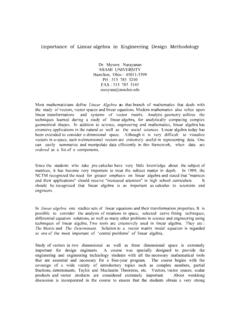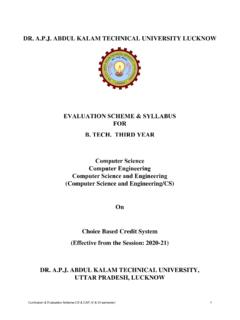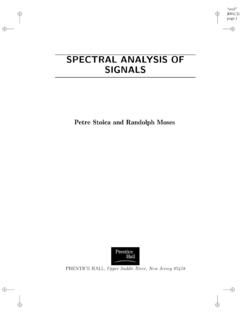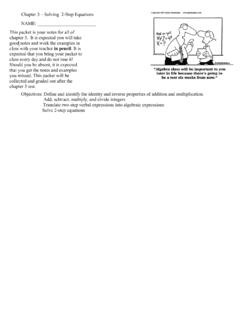Transcription of Continuum Mechanics - Massachusetts Institute of …
1 Continuum MechanicsVolume II of Lecture Notes onthe Mechanics of SolidsRohan AbeyaratneQuentin Berg Professor of MechanicsMIT Department of Mechanical EngineeringandDirector SMART CenterSingapore MIT Alliance for Research and TechnologyCopyrightc Rohan Abeyaratne, 1988 All rights May 20123 Electronic PublicationRohan AbeyaratneQuentin Berg Professor of MechanicsDepartment of Mechanical Engineering77 Massachusetts Institute of TechnologyCambridge, MA 02139-4307, USAC opyrightc by Rohan Abeyaratne, 1988 All rights reservedAbeyaratne, Rohan, Continuum Mechanics , Volume II of Lecture Notes on the Mechanicsof Solids. / Rohan Abeyaratne 1st Edition Cambridge, MA and Singapore:ISBN-13: 978-0-9791865-1-6 ISBN-10: 0-9791865-1-XQCP lease send corrections, suggestions and comments 28 May 20204iDedicated toPods and Nangifor their gifts of love and TO READERI had hoped to finalize this second set of notes an year or two after publishing Volume Iof this series back in 2007.
2 However I have been distracted by various other interesting tasksand it has sat on a back-burner. Since I continue to receive email requests for this secondset of notes, I am now making Volume II availableeven though it is not as yet complete. Inaddition, it has been cleaned-up at a far more rushed pace than I would have the future, I hope to sufficiently edit my notes on Viscoelastic Fluids and Microme-chanical Models of Viscoelastic Fluids so that they may be added to this volume; and if Iever get around to it, a chapter on the mechanical response of materials that are affected byelectromagnetic would be most grateful if the reader would please inform me of any errors in the notesby emailing me the period 1986 - 2008, the Department of Mechanical Engineering at MIT offereda series of graduate level subjects on the Mechanics of Solids and Structures that : Mechanics of Solid Materials, : Mechanics of Continuous Media, : Solid Mechanics : Elasticity, : Solid Mechanics : Plasticity and Inelastic Deformation, : Advanced Mechanical Behavior of Materials, : Structural Mechanics .
3 Finite Element Analysis of Solids and Fluids, : Molecular Modeling and Simulation for Mechanics , : Computational Mechanics of the years, I have had the opportunity to regularly teach the second and third ofthese subjects, and (formerly known as ), and the current four volumesare comprised of the lecture notes I developed for them. First drafts of these notes wereproduced in 1987 (Volumes I and IV) and 1988 (Volumes II) and they have been corrected,refined and expanded on every subsequent occasion that I taught these classes. The materialin the current presentation is stillmeant to be a set of lecture notes, not a text book.
4 It hasbeen organized as follows:Volume I: A Brief Review of Some Mathematical PreliminariesVolume II: Continuum MechanicsVolume III: A Brief Introduction to Finite ElasticityVolume IV: ElasticityThis is Volume appreciation for Mechanics was nucleated by Professors Douglas Amarasekara andMunidasa Ranaweera of the (then) University of Ceylon, and was subsequently shaped andgrew substantially under the influence of Professors James K. Knowles and Eli Sternbergof the California Institute of Technology. I have been most fortunate to have had theopportunity to apprentice under these inspiring and distinctive would especially like to acknowledge the innumerable illuminating and stimulatinginteractions with my mentor, colleague and friend the late Jim Knowles.
5 His influence onvime cannot be am also indebted to the many MIT students who have given me enormous fulfillmentand joy to be part of their am deeply grateful for, and to, Curtis Almquist SSJE, friend and understanding of elasticity as well as these notes have benefitted greatly from manyuseful conversations with Kaushik Bhattacharya, Janet Blume, Eliot Fried, Morton , Richard D. James, Stelios Kyriakides, David M. Parks, Phoebus Rosakis, StewartSilling and Nicolas Triantafyllidis, which I gratefully I of these notes provides a collection of essential definitions, results, and illus-trative examples, designed to review those aspects of mathematics that will be encounteredin the subsequent volumes.
6 It is most certainlynotmeant to be a source for learning thesetopics for the first time. The treatment is concise, selective and limited in scope. For exam-ple, Linear algebra is a far richer subject than the treatment in Volume I, which is limitedto real 3-dimensional Euclidean vector topics covered in Volumes II and III are largely those one would expect to see coveredin such a set of lecture notes. Personal taste has led me to include a few special (but stillwell-known) topics. Examples of these include sections on the statistical mechanical theoryof polymer chains and the lattice theory of crystalline solids in the discussion of constitutiverelations in Volume II, as well as several initial-boundary value problems designed to illustratevarious nonlinear phenomena also in Volume II; and sections on the so-called Eshelby problemand the effective behavior of two-phase materials in Volume are a number of Worked Examples and Exercises at the end of each chapter whichare an essential part of the notes.
7 Many of these examples provide more details; or the proofof a result that had been quoted previously in the text; or illustrates a general concept; orestablishes a result that will be used subsequently (possibly in a later volume).The content of these notes are entirely classical, in the best sense of the word, and noneof the material here is original. I have drawn on a number of sources over the years as Iprepared my lectures. I cannot recall every source I have used but certainly they includethose listed at the end of each chapter. In a more general sense the broad approach andphilosophy taken has been influenced by:Volume I: A Brief Review of Some Mathematical Gelfand and Fomin,Calculus of Variations, Prentice Hall, Knowles,Linear Vector Spaces and Cartesian Tensors, Oxford University Press,New York, II: Continuum MechanicsP.
8 Chadwick, Continuum Mechanics : Concise Theory and Problems, Dover, Ericksen,Introduction to the Thermodynamics of Solids, Chapman and Hall, Gurtin,An Introduction to Continuum Mechanics , Academic Press, Gurtin, E. Fried and L. Anand,The Mechanics and Thermodynamics of Con-tinua, Cambridge University Press, K. Knowles and E. Sternberg,(Unpublished) Lecture Notes for AM136: Finite Elas-ticity, California Institute of Technology, Pasadena, CA Truesdell and W. Noll, The nonlinear field theories of Mechanics , inHandb uch derPhysik, Edited by S. Fl ugge, Volume III/3, Springer, III: Gurtin, The linear theory of elasticity, inMechanics of Solids - Volume II, editedby C.
9 Truesdell, Springer-Verlag, K. Knowles,(Unpublished) Lecture Notes for AM135: Elasticity, California Instituteof Technology, Pasadena, CA, E. H. Love,A Treatise on the Mathematical Theory of Elasticity, Dover, P. Timoshenko and Goodier,Theory of Elasticity, McGraw-Hill, following notation will be used in Volume II though there will be some lapses (forreasons of tradition): Greek letters will denote real numbers; lowercase boldface Latin letterswill denote vectors; and uppercase boldface Latin letters will denote linear , for example, , , ..will denote scalars (real numbers);x,y,z,..will denote vectors;andX,Y,Z,..will denote linear transformations.
10 In particular, o will denote the nullvector while 0 will denote the null linear result of this notational convention is that we willnotuse the uppercase bold letterXto denote the position vector of a particle in the reference configuration. Instead we usethe lowercase boldface lettersxandyto denote the positions of a particle in the referenceand current Some Preliminary Bodies and Configurations.. Reference Configuration.. Description of Physical Quantities: Spatial and Referential (or Eulerian andLagrangian) forms.. Eulerian and Lagrangian Spatial Derivatives.. Motion of a Body.. Eulerian and Lagrangian Time Derivatives.















